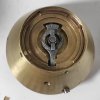Hello,
I wan't to show another long-time restoration project which I just finished. Since some years I had an experimental mechanical time fuze which is much comparable to a German "Dopp. Z. 16" fuze but it was missing it's steel cap. Some months ago I got a second one which is basically the same but without a percussion system. This one is much comparable to a "Dopp. Z. 16. o. A.Z.". The clockwork of both fuzes seems to be the same as in the Dopp. Z. 16 but the Dopp. Z. 16 has an additional set-back ring which prevents a rotation of the fuze (setting-)cap when it is fired. I think my experimental models are made after the Dopp.Z.16 fuzes because it shares more construction details with later Zt.Z.S/30 fuzes than with the Dopp.Z.16 series.
First of all I upload two pictures. One is showing the fuze with it's clockwork and the seat for the cap. And the second picture shows a small brass ring which originally was connected to the fuze cap. Both the brass ring + the cap were used to set the time of ignition.
I wan't to show another long-time restoration project which I just finished. Since some years I had an experimental mechanical time fuze which is much comparable to a German "Dopp. Z. 16" fuze but it was missing it's steel cap. Some months ago I got a second one which is basically the same but without a percussion system. This one is much comparable to a "Dopp. Z. 16. o. A.Z.". The clockwork of both fuzes seems to be the same as in the Dopp. Z. 16 but the Dopp. Z. 16 has an additional set-back ring which prevents a rotation of the fuze (setting-)cap when it is fired. I think my experimental models are made after the Dopp.Z.16 fuzes because it shares more construction details with later Zt.Z.S/30 fuzes than with the Dopp.Z.16 series.
First of all I upload two pictures. One is showing the fuze with it's clockwork and the seat for the cap. And the second picture shows a small brass ring which originally was connected to the fuze cap. Both the brass ring + the cap were used to set the time of ignition.









































